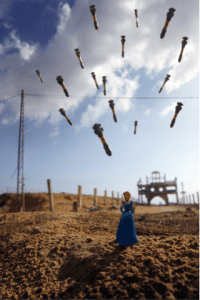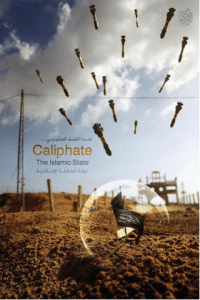Posted in Intellectual Property
organization ISIS holds much territory in Syria and Iraq and has inspired attacks in Europe and California. It engages in genocide, recruits child soldiers, has given its blessing to the rape of enslaved women and broadcasts mass murder regularly on the internet. In addition to a long list of war crimes it also violates copyright laws.
Many artists are not surprised if their works are used without permission, whether it’s photos, artwork or music. In one instance a piece of art created in the hopes of stopping violence is being used by ISIS to promote it, according to Fstoppers.
Brian McCarty created a number of photographs based on drawings of refugee children. He works with them by using art therapy to help them cope with their situation. The image, entitled “Cinderella” is from his series WAR-TOYS.

They took the photo and altered it so that their flag and an open Quran are being protected by a bubble (below). The text reads, “Even if war destroys everything, the Islamic sign and state is protected and will never fall down.”

There is no such thing as an “international copyright” that protects a work.
- Prohibitions against unauthorized use in a particular country are based on the laws of that country.
- Most countries offer protection to foreign works under certain conditions and they have been greatly simplified thanks to international copyright treaties and conventions.
- There are two main international copyright conventions, the Berne Convention for the Protection of Literary and Artistic Works (Berne Convention) and the Universal Copyright Convention (UCC). The United States has been a member of the UCC since 1955 and became a member of the Berne Convention in 1989.
Generally,
- The works of an author who is a citizen or resident of a nation that signed on to these treaties can claim their protection. There can also be protection if the work us first published in a member country or published within 30 days of first publication in a Berne Convention country.
- The Berne Convention has no formal requirements for protection. Under the UCC a notice should consist of the symbol © with the year of first publication and the name of the copyright owner (example: © 2006 John Doe). It must be located in a way and location to give reasonable notice of the copyright claim.
- The use of a copyright notice is optional under U.S. law but using one makes sense because it can defeat a defense of “innocent infringement” of the copyright.
If you own a copyright that you believe has been infringed, either here in the U.S. or overseas, contact our office. If the law’s been broken by a criminal gang or terrorist organization your options may be limited, but we can discuss the situation anyway. Creativity isn’t limited to the art world and copyright infringers, it can be very handy when engaged in litigation too.
